
School Programs
Bring your students to the Faulkner Planetarium for an unforgettable educational experience. All shows include a question and answer session with a planetarium staff member. School programs are presented Tuesdays through Fridays, September through May. Contact our Events Coordinator at (208) 732-6657 or (208) 736-3059 to make reservations. Please note: Reservations are not final until you receive written confirmation.
| School Program Admission | Price per person* | Minimum charge† |
|---|---|---|
| Planetarium show | $3.00 | $75.00 |
| Planetarium double feature (any two planetarium programs) | $5.00 | $125.00 |
| Museum or observatory educational program | $2.00 | $20.00 |
| Observatory nighttime program (after regular museum hours) | $3.00 | $75.00 |
| Explore Herrett package (Three programs of your choice, one planetarium show maximum. Excludes after-hours observatory programs.) | $6.00 | $150.00 |
| Museum galleries scavenger hunt | $1.00 | N/A |
| *Please note: All chaperones and teachers are charged for program. | ||
| †Based on 25 attendees for planetarium and after-hours observatory programs; 10 attendees for museum, reptile, and daytime observatory programs. If you have fewer than the minimum number in your group, you are responsible for the minimum charge. | ||
Programs Available for the 2023-24 School Year:
Seasonal Programs:
| Suggested Grade Level | |||||||||||||||
|---|---|---|---|---|---|---|---|---|---|---|---|---|---|---|---|
| Program Title | Pre-K | K | 1st | 2nd | 3rd | 4th | 5th | 6th | 7th | 8th | 9th | 10th | 11th | 12th | 12+ |
| Let It Snow (available 11/30 - 12/21 only) | |||||||||||||||
| The Star of Bethlehem (with a live sky tour*) (available 11/30 - 12/21 only) | |||||||||||||||
| Programs run from 45 to 60 minutes including seating, introduction, question and answer, and live sky show segment (where indicated). | |||||||||||||||
"One World, One Sky: Big Bird's Adventure"
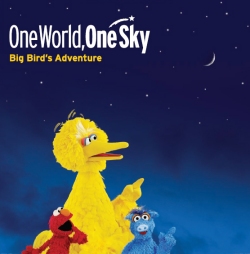
Join Sesame Street’s Big Bird, Elmo, and Elmo’s friend from faraway China, Hu Hu Zhu, as they learn about the sky in this fun adventure, best suited for children ages 4-6. The three friends learn about sunsets and finding starry patterns like the Big Dipper in the night sky.
Using their imaginations, Elmo and Hu Hu Zhu even travel to the moon, where they discover they can jump higher and kick a soccer ball farther, but can't fly a kite, and must wear space helmets to breathe. Returning to Earth, they realize they can see the same stars from their homes in the United States and China.
Students are encouraged to use their imaginations and actively participate in this program.
Recommended Grades
- Pre-K through 1st (ages 4-6)
Concepts
- The sun is a star
- Day and night
- Star patterns like the Big Dipper
- The moon
- Physical characteristics of the moon
- Faraway places
- Using one's imagination
"The Little Star That Could"
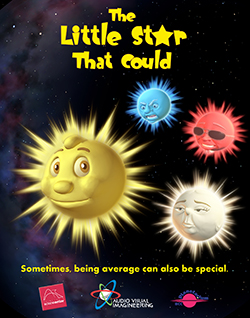
Poor Little Star, he is new to the universe and he just wants to see what else is out there. He seems to be just an average star, and, judging by the reactions of the other stars he meets, he is never going to be anything special. If only he could get himself some planets to make him special and give him a name. On his journey of discovery, Little Star learns what makes each star special. For some, it is their color and temperature, for others it may be their planets, and for others it is their stellar companions. Along the way, he discovers that stars can combine to form larger groups, like star clusters and galaxies. Eventually, Little Star finds his planets who tell them a little about themselves and give him his special name, the Sun.
Recommended Grades
- K through 2nd
Concepts
- Star formation
- Star colors and temperatures
- Multiple star systems
- Star clusters
- Galaxies
- Solar systems
- Planets, including basic information about the planets of our solar system
"Legends of the Night Sky: Orion" (w/ live sky tour)
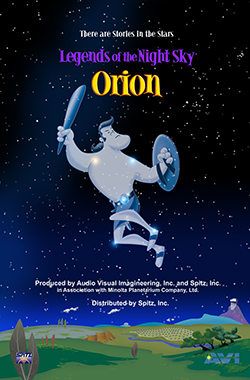
The legend of Orion, the mighty hunter, comes to life! From his humble beginnings in the faraway land of Thrace, to his daring hunting exploits, and romances, on the islands of Chios and Crete, Orion and his faithful hunting dogs, Sirius and Procyon, move from adventure to adventure. Eventually, having earned the scorn of Apollo, Orion battles Scorpius, the scorpion, in a fight to the death. Discover how, upon Orion’s demise, he was placed into the heavens for all of us to see in the winter, right there with his two faithful companions.
A live sky tour follows the program, featuring constellations, planets, the moon and other items of interest currently visible in the sky, with tips for finding your way around in the heavens on the next clear night, and stories about the stars.
Recommended Grades
- K through 5th
Concepts
- Greek mythology
- Constellations
- Star gazing
- Star hopping
"Legends of the Night Sky: Perseus and Andromeda" (w/ live sky tour)
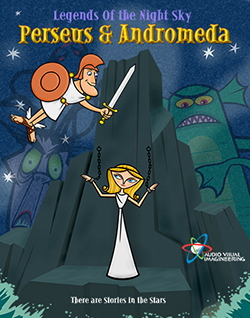
It is the classic Greek story of the princess and her hero come to life! Poor Andromeda is being sacrificed to the sea monster Cetus for the sins of her mother, Cassiopeia. Just what lead to this calamity? Where is her father, Cepheus, in all this? It all sounds so terrible; she needs a hero. Never fear for Perseus is almost here! First, Perseus must deal with the Gorgon, Medusa, and then he will deal with Andromeda’s situation. Will the story end happily? Join us to find out.
A live sky tour follows the program, featuring constellations, planets, the moon and other items of interest currently visible in the sky, with tips for finding your way around in the heavens on the next clear night, and stories about the stars.
Recommended Grades
- K through 5th
Concepts
- Greek mythology
- Constellations
- Star gazing
- Star hopping
"Serengeti: A Journey to the Heart of Africa"
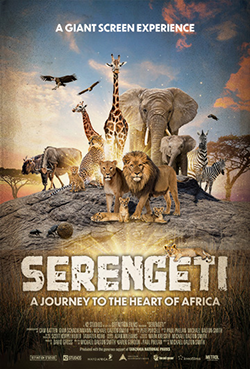
Come explore the African Serengeti in this beautiful giant screen film. Encounter one of the world's oldest and most vibrant ecosystems, whose story is told through the million-animal, ever-moving, migration of the wildebeest. Here, each creature, from the smallest insect to the largest land mammal, has an important role to play. What series of events happened to create this incredible ecosystem? Can we learn its intricacies to save and protect the Serengeti? Come see how this extraordinary place came to be.
A K-8th educators' guide is available upon request.
Recommended Grades
- K through 12th+
Concepts
- Ecosystems
- Biodiversity
- Habitats
- Migration
- Predators
- Scavengers
- Herbivore
- Omnivore
- Carnivore
- Volcanism
- Seasons of the Serengeti
- Web of life
"The Accidental Astronauts: An Earth Sun Moon Adventure"
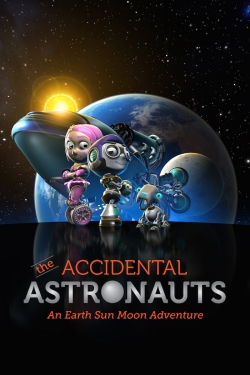
Follow the adventures of Cy, Annie and Armstrong (Cy’s dog), as they embark upon an unexpected journey into space! Armstrong gets the kids into a little trouble with his antics on a field trip to the science center. From there the adventure only grows as the three are whisked into space by a wise-cracking spaceship named Halley. It's off to the moon for a little exploring, followed by a visit to the sun. What wonders will they discover? Will they make it back to Earth? This wonderful adventure show is based on a story by award-winning children's author Kristyn Crow.
Recommended Grades
- 1st through 2nd
Concepts
- Day and night
- Earth rotates
- The sun is a star
- The earth orbits the sun
- The moon orbits the earth
- Moon phases
- Physical nature of the moon (maria, mountains, hills, valleys, craters)
- Lunar environment (heat and cold, low gravity, lack of atmosphere)
- Size and physical nature of the sun
- Uniqueness of Earth
"Perfect Little Planet"
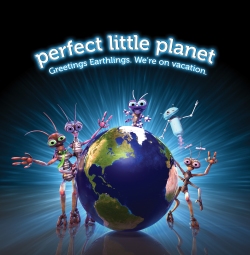
Discover our solar system through a new set of eyes—those of a family from another star system, seeking the perfect vacation spot. Fly over the icy surface of dwarf planet Pluto, dive over Miranda's towering ice cliffs, sail through the rings of Saturn, brave Jupiter's raging lightning storms, and kick up some red dust on Mars. With the best vacation spots in the solar system to choose from, where would your students visit?
Recommended Grades
- 1st through 3rd
Concepts
- Solar system
- Sun
- Planets
- Moons
- Asteroids
- Comets
- Gas giants
- Rocky midgets
- Icy dwarfs
- Physical nature of sun and planets
- Rings
- Atmospheres
- Life forms on Earth
"Sea Lions: Life by a Whisker"
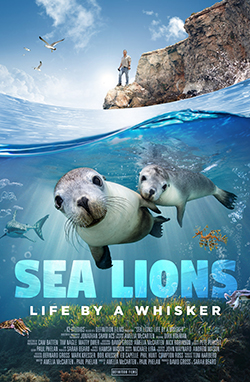
Meet the Whiskers, a family of endangered Australian sea lions. Baby Otto has no one looking out for her, other than her mother. Then again, maybe there is somebody else; Ranger Dirk Holman is charged with preserving this species along Australia's rugged southern coast. This coming-of-age tale follows Otto and her mother as they struggle to survive, and follows Dirk as he travels to California to learn the secrets to the recovery of the California sea lion. Will Dirk discover practices applicable to preserving the Australian sea lion? Will Otto survive the harsh realities of life off the southern Australian coast? Discover the answers in this film that is sure to engage your students.
Recommended Grades
- 2nd through 12th+
Concepts
- Species conservation and preservation
"The Arctic: Our Last Great Wilderness"
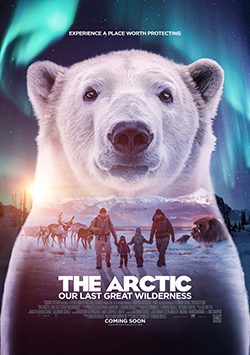
Imagine a place that is vast, wild and untouched, where some of the world's greatest wildlife spectacles unfold. For five years, Florian Schulz has lived in and filmed the Arctic to reveal it to audiences around the globe. Join Florian as he tracks the Porcupine Caribou herd on the longest animal migration on Earth, and witnesses pregnant female polar bears denning along the coastal plain.
Northeastern Alaska's Arctic National Wildlife Refuge is one of the wildest places left on the planet — a symbol of wilderness that few have ever seen. “The Arctic: Our Last Great Wilderness,” the first cinematic exploration of this little-known land, brings you to a world that has evolved intact and wild since the beginning of time.
Produced by Terra Mater Factual Studios, distributed by Cosmic Pictures, and written and directed by veteran IMAX&tm; producer Myles Connolly and award-winning photographer and cinematographer Florian Schulz.
Recommended Grades
- 3rd through 12th+
Concepts
- Species conservation and preservation
"GranPa & Zoe – Mission: Light" (w/ live sky tour)
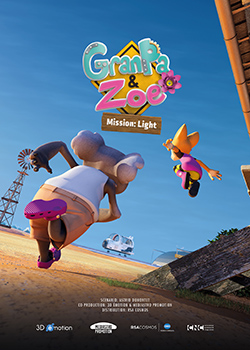
A typical day for GranPa and Zoe in the Australian outback is interrupted when GranPa's old nemesis, Bogbog, attempts to block sunlight from reaching Earth. It's up to GranPa and Zoe to put a stop to Bogbog's diabolical scheme. Exploring and utilizing different wavelengths of the electromagnetic spectrum, the heroes hope to foil Bogbog, educate audiences about the nature of color and light, and save the day.
A live sky tour follows the program, featuring constellations, planets, the moon and other items of interest currently visible in the sky, with tips for finding your way around in the heavens on the next clear night, and stories about the stars.
Recommended Grades
- 3rd through 5th
Concepts
- Electromagnetic spectrum
- Color
- Light waves
- Energy
"Beyond the Sun: In Search of a New Earth"
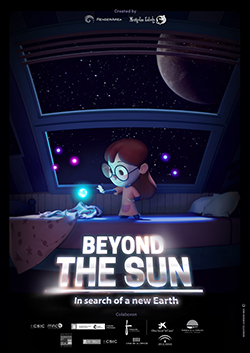
Celeste is a curious young girl; she is especially enamored of the planets in the solar system. Celeste is about to meet a new friend, Moon, who knows a lot about planets, not just those of the solar system, but about exoplanets; planets that orbit other stars. We cannot see these planets, yet astronomers can detect their presence around stars and deduce a little about what they may be like. How? Well leave that up to Moon to explain. The transit and radial velocity methods of detecting planets are explained along with how that information can tell us about the size and possible conditions on those planets. Moon also happily explains what a planet must be like in order for it to have the possibility of life.
A live interactive presentation covering light pollution, locations of planetary systems, an in-depth explanation of transit and radial velocity detection methods, and a short tour of the current night sky follow the movie presentation.
The show (movie portion only) is also available in Spanish. Request “Mas alla del Sol: En busca de una nueva Tierra.”
An educator's guide with classroom activities is available for this program upon request.
Recommended Grades
- 3rd through 5th
Concepts
- Brief overview of solar system
- Other stars have planets (exoplanets)
- Transit method of planetary detection
- Radial velocity method of planetary detection
- Conditions on other planets
- Requirements for life
- Light pollution
- Search for planets that are Earth like
"Earth, Moon & Sun" (w/ live sky tour)

Coyote has a razor-sharp wit and thinks he knows a lot about the sky, but as it turns out, he’s a little confused. Coyote, adapted from American Indian oral tradition, gets set straight with his many misconceptions about lunar phases, eclipses and other puzzles of the sky. What is the nature of the sun and moon? How do their movements and interactions affect their appearance in the sky? This is a great program to reinforce students' understanding of the sun, moon, and stars, and dispel common misconceptions in an entertaining and engaging way.
A live sky tour follows the program, featuring constellations, planets, the moon and other items of interest currently visible in the sky, with tips for finding your way around in the heavens on the next clear night, and stories about the stars.
Recommended Grades
- 3rd through 6th
Concepts
- Physical nature of the sun and moon
- Rotation of earth and moon
- Revolution of earth
- Lunar phases
- Lunar and solar eclipses
- Manned exploration of the moon
- Native American sky lore
"Ningaloo: Australia's Other Great Reef"

A magical expedition with a 24-year-old marine biologist, Anna Cresswell, reveals intimate secrets of one of the world's largest fringing coral reefs, stretching 260 km along the northwest coast of Western Australia and visible from space. Travel in a two-person submarine, Odyssea, on an underwater adventure to explore an environment rich in coral, a highway for the planet's largest and smallest fish, including the whale shark. This live action, fulldome film is an immersive voyage of discovery as we witness Ningaloo Reef and the rare natural wonder and spectacle of life – coral spawning.
Recommended Grades
- 3rd through 12th+
Concepts
- Reef ecosystems
- Effects of climate change
- Interconnectivity of an ecosystem (from smallest to largest creatures)
- Coral reproduction
- Food chain
"CapCom Go! The Apollo Story" (w/ live sky tour)

On July 20, 1969, the United States landed astronauts Neil Armstrong and Buzz Aldrin on the Moon. This was the culmination of nearly a decade of efforts by thousands of people working for NASA and private contractors. It was an incredible accomplishment and NASA would go on to land five more sets of astronauts on the Moon, the last in December of 1972. Why did we go to the Moon? How did we go to the Moon? Why have we not been back since that final mission? This immersive, historical documentary highlights the achievements of the Apollo program. The movie ends with a call to the future engineers, technicians, astronauts, and other STEM careers that, "SPACE NEEDS YOU!"
A live sky tour follows the program, featuring constellations, planets, the moon and other items of interest currently visible in the sky, with tips for finding your way around in the heavens, and stories about the stars.
Recommended Grades
- 3rd through 12th+
Concepts
- History of Apollo program
- Overview of cold war space race
- Navigational challenges in space
- Lunar surface conditions
- Apollo spacecraft configuration
- Progression of skills/knowledge to get to the Moon
- Teamwork of scientists, engineers, and mathematicians
- Progression of Apollo missions
- Overview of Apollo 11 mission
- Review of subsequent Apollo missions to the Moon
- Living/working in space
- Need for future STEM professionals
"Extreme Weather"
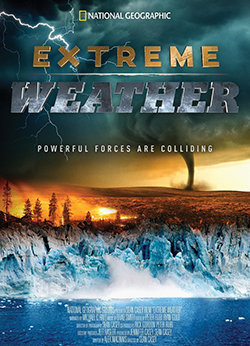
Climate change is rapidly affecting our land, oceans, and atmosphere. Extreme weather, driven by the changing climate, gives rise to powerful hurricanes, torrential downpours, and drought, resulting in natural disasters. National Geographic brings you face to face with Mother Nature at her most dangerous in this film. Experience the action as massive chunks of ice shear off a rapidly melting glacier in Alaska. In the Midwest, cameras roll as storm chasers risk their lives to capture data as deadly tornadoes race toward them. In drought-ravaged California, filmmakers embed themselves with firefighters trying to contain raging wildfires on the front lines. The film unveils the surprising links between these three areas, demonstrating how small changes in one area can have major effects elsewhere.
Recommended Grades
- 3rd through 12th+
Concepts
- Climate change
- Global warming’s effect on weather
- Glacier retreat
- Oceans as the engines of global weather
- Tornado development
- Drought induced wildfire
- Sea level rise
- Interconnectivity of systems that shape global climate
- Regional weather and extreme weather
"Volcanoes: The Fires of Creation"
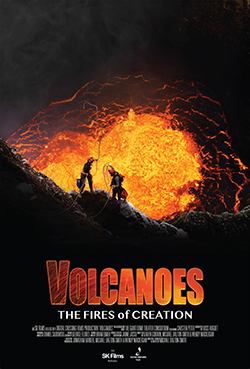
Southern Idaho, a landscape sculpted by volcanic forces. From the stark beauty of Craters of the Moon with its extinct spatter cones and plains of frozen lava to other lava flows across southern Idaho, it is clear that volcanoes played a role in shaping the land on which we live. Today, active volcanoes hold an allure. It could be from their rarity or the danger they pose. Witness the incredible tale of the birth of our planet in which volcanoes played a crucial role. Step into the present and follow along as National Geographic photographer Carsten Peter takes you along on a personal journey to see volcanoes from the inside, revealing their hidden mysteries. Get up close to the 2018 eruption of Hawaii's Kilauea and watch as Carsten attempts to descend to a lava lake as it roils and churns, launching fountains of lava. You may never want to get as close to an active volcano in real life as Carsten does, but you can go there with him from the safety of your seat in the planetarium.
Every rock tells a story.
Recommended Grades
- 3rd through 12th+
Concepts
- Formation of the Earth
- Earth-Theia impact
- Formation of the Moon
- Volcanoes' role in making the Earth the planet it is
- Plate tectonics
- Atmospheric creation through outgassing
- Possible role in creation of Earth's oceans
- Submarine volcanic activity
- Dynamics of volcanic eruptions
- Benefits of ash to ecosystems
- Dangers posed by volcanoes
"Áróra" (w/ live sky tour)
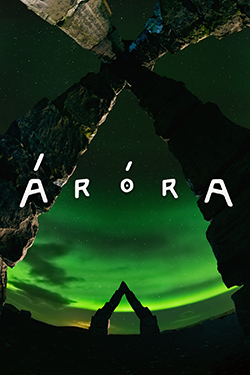
The northern lights, scientifically known as the aurora borealis (or aurora australis in the southern hemisphere), are one of Earth's most fascinating natural phenomena. Steeped in many mythologies, these ethereal lights dance across polar skies in ghostly fashion. Discover what generates the aurora here on Earth and on other planets and moons. Come, be captivated by Áróra, the Icelandic goddess of the dawn and the aurora, as she tells tales of herself and her sister aurorae. Behold the wonder and beauty of the aurora as seen from Iceland!
A live sky tour follows the program, featuring constellations, planets, the moon and other items of interest currently visible in the sky, with tips for finding your way around in the heavens, and stories about the stars.
Recommended Grades
- 3rd through 12th+
Concepts
- Solar flares and coronal mass ejections
- Solar wind
- Earth's magnetic field
- Types of aurorae (rays, arcs, bands)
- Cultural traditions surrounding aurorae
"Solar System Odyssey" (w/ live sky tour)
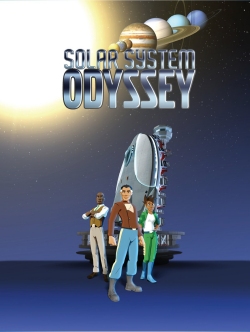
Sometime in the future…
A time has come when humans have depleted our home planet's resources. Multi-billionaire business tycoon Warren Trout, seeking to secure new frontiers for Trout Enterprises, recruits former Space Fleet Command pilot Jack Larsen for a mission to find a suitable extraterrestrial location for human colonization. Now Jack finds himself searching the solar system, but he isn’t alone. It seems that Trout’s precocious daughter, Ashley, has stowed away onboard his spaceship. Together they embark upon a wild ride through the solar system trying to answer these questions: How are the worlds of the solar system alike? How are they different? What features must a world possess for humans to live there?
Will Larson and Ashley find a suitable location? Will they even survive this mission? Find out in this action-packed adventure.
A live sky tour follows the program, featuring constellations, planets, the moon and other items of interest currently visible in the sky, with tips for finding your way around in the heavens, and stories about the stars.
Recommended Grades
- 4th through 6th
Concepts
- Requirements for long-term human survival away from Earth (water, atmosphere/oxygen, food, energy/heat, gravity, pressurized environment, and radiation protection)
- Overview of the solar system
- Space exploration
- Physical nature of Titan, Callisto, Europa, and Io
- Earth as a unique habitat for life
"Dinosaurs: A Story of Survival"
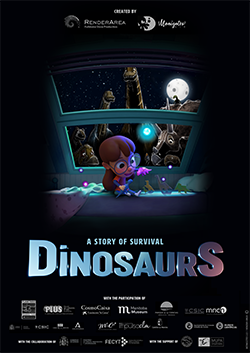
Celeste wants to fold an origami dinosaur for a class presentation, but can't figure it out. Luckily, her good friend Moon is here to help with all things dinosaurs. Together, they travel back in time to a very different Earth and discover many, many, dinosaurs. Little dinosaurs? Got 'em! Big dinosaurs? Got 'em! Feathered dinosaurs? Got 'em! Join these two friends as they explore the nature of dinosaurs and what led to their extinction. Or, did some survive? Discover what a chicken has to do with a dinosaur!
This show (movie portion only) is also available in Spanish. Request “Somos Estrellas.”
Recommended Grades
- 4th through 12th+
Concepts
- Early Earth (geologic and climate changes over time)
- Periods of the dinosaurs (Triassic, Jurassic, and Cretaceous)
- Pangea and Panthalassa
- Mass extinctions
- Dinosaur evolution (adaptations)
- Dinosaur physiology
- Speciation
- Asteroid and comet impacts
- Dinosaur extinction and survival
"Life's Question" (w/ live sky tour)
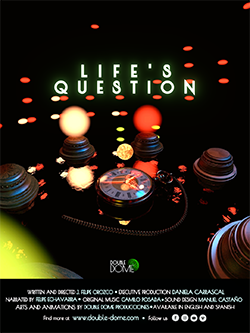
Life flourishes on Earth, begging the question of whether life might exist beyond our planet. What are the essential elements of life, as we know it? How did these elements come into existence? What conditions are favorable to life? Life's Question delves into these questions and others to explore not only the origins of life on Earth, but also the possibilities for finding life beyond our shores. Discover the all-important six "CHNOPS" elements that comprise and drive terrestrial life.
A live sky tour follows the program, featuring constellations, planets, the moon and other items of interest currently visible in the sky, with tips for finding your way around in the heavens on the next clear night, and stories about the stars.
Recommended Grades
- 4th through 12th+
Concepts
- CHNOPS elements (carbon, hydrogen, nitrogen, oxygen, phosphorus, and sulfur)
- Creation of elements via nuclear fusion
- Conditions favorable to life
- Potential abodes of life in the Solar System
"Astronaut" (w/ live sky tour)

Mankind’s greatest endeavor is the exploration of space. What does it take to become an astronaut, and participate in the incredible journey? Your students will find out by experiencing a rocket launch from inside an astronaut's body. Explore both inner and outer space in this exciting show. Just what perils lurk beyond Earth's protective atmosphere and magnetic field? Find out as test astronaut "Chad" is subjected to conditions simulating the harshest environment of all—space. Does Chad have the right stuff? Would you?
A live sky tour follows the program, featuring constellations, planets, the moon and other items of interest currently visible in the sky, with tips for finding your way around in the heavens on the next clear night, and stories about the stars.
Recommended Grades
- 4th through 12th+
Concepts
- Human biology
- Space environment
- Physiological effects of space environment
"Birth of Planet Earth" (w/ live sky tour)
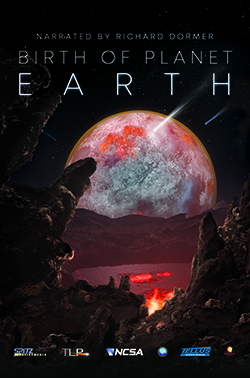
Teachers, one of the most popular questions we get is some variation on, "How was the Earth made?" The concept of the Earth and the other planets forming from a huge cloud of gas and dust is a tough one for students to grasp. This show does an incredible job of explaining and visualizing how the Earth was born. Your students will see the solar nebula collapse and countless dust particles clumping together forming larger bodies, impacts of asteroid sized bodies forming protoplanets. Observe the Earth-Theia collision resulting in the formation of the Moon. Four and a half billion years of time roll by as the solar system, as we now know it, comes into being and your students gain an understanding of how our Earth formed.
A live sky tour follows the program, featuring constellations, planets, the moon and other items of interest currently visible in the sky, with tips for finding your way around in the heavens on the next clear night, and stories about the stars.
An educator's guide with classroom activities is available for this program upon request.
Recommended Grades
- 4th through 12th+
Concepts
- Supernovae synthesis of heavy elements
- Star forming nebulae
- Planetesimal formation
- Protoplanetary disc environment
- Planetary formation
- Celestial impacts
- General characteristics of early Earth
- Earth-Theia collision
- Formation of the Moon
- Moon's stabilizing effects on Earth
- Asteroid bombardment period
- Evolution to a watery world
- Atmospheric development
- Rise of life
- Life's chemistry (photosynthesis)
"Dream to Fly"
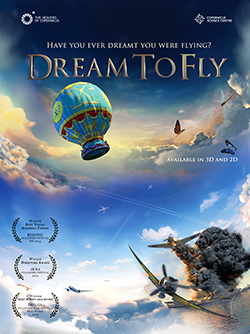
Have you ever had a dream that you were flying? What does it take to break the bonds of Earth and soar like a bird? Explore humankind’s quest for flight including the ancient myths of Aladdin on his flying carpet, the vimanas—mechanical winged flying machines—of ancient Sanskrit writings, the kites of ancient China, Leonardo Da Vinci's scientific study of wings and drawings of flying machines, and the pioneers of actual flight: France’s Montgolfier brothers, England’s George Cayley, Germany’s Otto Lilienthal and the United States' Wright brothers. Learn how history also shaped the early days of powered aviation with the advent of World Wars. This poetic and visually stunning show takes you on a journey from the time when humans could only dream of flying to our modern day world where all one needs to fly is a ticket. Have you ever dreamed of flying?
Recommended Grades
- 4th through 12th+
Concepts
- Mankind's desire for flight
- Flight in mythology
- Chinese use of kites
- Da Vinci's studies of flying creatures; drawings of wings; prototype parachutes, gliders, and a helicopter
- History of flight/aviation
- Principles of flight (drag, lift, and propulsion)
- Pioneers of flight and aviation: Sir George Cayley, Montgolfier Brothers, Otto Lilienthal, and the Wright Brothers
- Impact of war on the evolution of aviation
- Altruistic aims of aviation
"Faster Than Light: The Dream of Interstellar Flight" (w/ live sky tour)
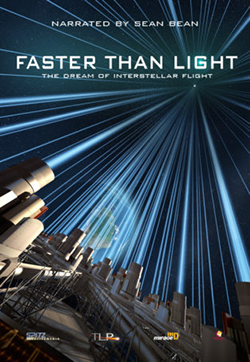
The impulse to strike out into the unknown, to see what is over the horizon, is as old as humanity. Today, a new horizon beckons. Scientists now believe solar systems fill our galaxy, including up to nine billion Sun-like stars with Earth-like planets.
Astronomers are racing to find habitable worlds, including any that might exist in the neighborhood of our Sun. If we find one, how will we get there? How long will it take? What spacecraft designs might one day conquer the voids of space?
Take a virtual ride aboard spacecraft of the future, based on new technologies designed to achieve ultra-high speeds, using exotic fuels and breakthrough concepts in physics. How far can our technology take us?
A live sky tour follows the program, featuring constellations, planets, the moon and other items of interest currently visible in the sky, with tips for finding your way around in the heavens, and stories about the stars.
An educator's guide with classroom activities is available for this program upon request.
Recommended Grades
- 4th through 12th+
Concepts
- Human exploration
- space exploration
- distances in space
- local interstellar neighborhood
- possible nature of Proxima Centauri's planet
- inefficiencies of chemical rockets
- gravitational slingshot
- space propulsion/spacecraft technologies (nuclear fission and fusion, lasers, antimatter, warp drive)
- dangers of space environment
- future exploration of exoplanets
"The Sun: Our Living Star" (w/ live sky tour)
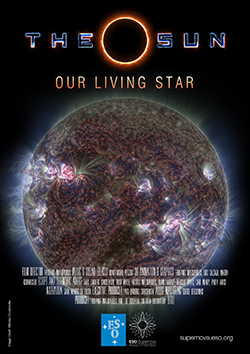
The Sun has shone on our world for four and a half billion years, the source of the energy that drives the winds, our weather, and all life. The passage of the Sun's fiery disc across the sky – day by day, month by month – is the way civilization tracks time. Although it is a typical dwarf star, the Sun consumes 600 million tons of hydrogen each second and is 500 times as massive as all the planets combined. Discover the secrets of our star and experience never-before-seen images of the Sun's violent surface in an immersive format.
A live sky tour follows the program, featuring constellations, planets, the moon and other items of interest currently visible in the sky, with tips for finding your way around in the heavens on the next clear night, and stories about the stars.
Recommended Grades
- 4th through 12th+
Concepts
- Sun's birth and age
- Sun as source of Earth's energy
- Solar ties to Earth's weather
- Dependence of life on the Sun
- Using the sun to track time
- Heliocentric model of solar system
- Sun's motions
- Sun compared to other stars
- Sun's physical structure and properties
- Nuclear fusion
- Remote observations of the Sun
- Electromagnetic spectrum
- Space weather
- Renewable energy
"Violent Universe: Catastrophes of the Cosmos" (w/ live sky tour)
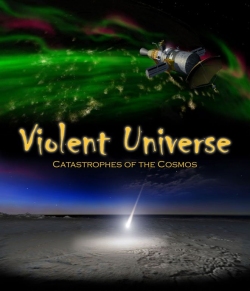
Few things appear more peaceful than a quiet, starry sky. Year after year, the same stars return, apparently inhabiting a tranquil and unchanging universe. Yet terrific, unseen forces shape the cosmos. Galaxies collide; supernova explosions rip stars apart, blasting deadly gamma rays across space; black holes in the hearts of galaxies devour whole stars; asteroids and comets streak past, occasionally crashing into Earth and catastrophically disrupting its ecosystems. In reality, the universe is a violent and dangerous place. What dangers lurk out there, and how safe is our planet?
A live sky tour follows the program, featuring constellations, planets, the moon and other items of interest currently visible in the sky, with tips for finding your way around in the heavens on the next clear night, and stories about the stars.
Recommended Grades
- 4th through 12th+
Concepts
- Violent forces of the cosmos
- Galactic collisions
- Galactic dust clouds
- Supernovae
- Black holes
- Meteors
- Meteor showers and storms
- Comet/asteroid/planetary collisions
- Cratering
- Gamma ray bursts
- The Milky Way's central black hole
"We Are Stars" (w/ live sky tour)
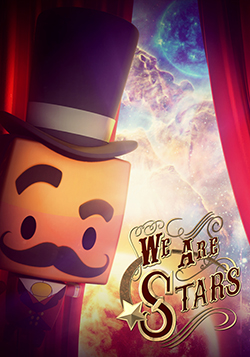
The carnival, with all of its rides and attractions, has come to town and the most incredible experience is the Time Master's odyssey through space and time. Entering the Time Master's tent leads to a whimsical overview of the history of the universe, starting with the Big Bang and ending in our present time. Discover how various processes inevitably progressed to the point that life arose on one small planet orbiting a yellow star. The Time Master's array of mechanical devices demonstrate key scientific concepts in simple terms, making it easier for one life form, humans, to understand where they came from. Sprinkle in a little humor along the way and this steampunk-themed show leads to the discovery that we are all made of stars.
A live sky tour follows the program, featuring constellations, planets, the moon and other items of interest currently visible in the sky, with tips for finding your way around in the heavens on the next clear night, and stories about the stars.
This show (movie portion only) is also available in Spanish. Request “Somos Estrellas.”
Recommended Grades
- 4th through 12th+
Concepts
- Big Bang
- Cosmology
- Stellar evolution
- Formation of elements through nuclear fusion
- Planetary formation
- Origins of primitive life
- Biological processes and evolution
"Space Oases"

We are watery creatures inhabiting a water world—a space oasis speeding between the orbits of Venus and Mars. Without water we cannot survive, let alone explore interplanetary space.
Water is plentiful on Earth, but space voyagers must bring water with them. A rocket's weight greatly affects its cost and how far it can travel, so finding water within the Solar System could greatly reduce the cost and difficulty of interplanetary exploration.
This program traces water across the whole Solar System, from deep lunar craters, to the scorching heat of the Venusian atmosphere, to Martian deserts, and the giant planets' frozen satellites. Come along to discover continent-sized ice floes; vast, hidden oceans; and the icy showers of cryovolcanoes.
Recommended Grades
- 5th through 12th+
"Cell! Cell! Cell! The Ex-CELL-ent Adventures of Raj and Sooki"
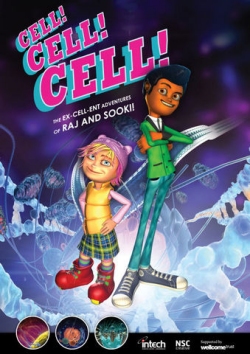
Join Raj and Sooki’s ex-CELL-ent adventure to explore the microscopic cells we're all made of. Students will see the wonderous human cell from within, witnessing how the various organelles and cell structures function. Genes and genetics are explained while examining egg fertilization, revealing how we acquire the individual DNA that makes us unique. Also detailed is the process of cell specialization to create the diverse biological systems within us, and how those systems interact to allow us to accomplish amazing feats.
This program is followed by a live, interactive exploration of the discovery of the cell, prokaryotic vs. eukaryotic cells, numbers and types of human cells, apoptosis (cell &ldquot;suicide&rdquot;), the number and role of bacteria in humans, and other incredible and amazing facts about the cells of the human body.
Recommended Grades
- 5th through 8th (may be suitable for high school biology classes)
Concepts
- Cell structure
- Cell membranes
- Organelles (lysosomes, mitochondria, nucleus)
- DNA and genes
- Fertilization
- Stem cells
- Fetal cell development
- Interaction between cellular systems (neurological, circulatory, muscular, etc.)
"Deep Sky" (w/ live sky tour)

For all its splendor, the starry sky we see overhead is but a sliver of the universe, because our eyes are ill-equipped to see dim, distant celestial objects. Telescopes and sensitive digital detectors reveal a "deep sky" of stellar birth and death, star clusters, distant galaxies, galactic collisions, the large-scale structure of the universe, and a background of cosmic radiation echoing across time.
A live sky tour follows the program, featuring constellations, planets, the moon and other items of interest currently visible in the sky, with tips for finding your way around in the heavens on the next clear night, and stories about the stars.
Recommended Grades
- 5th through 12th+
Concepts
- The human visual system
- Messier catalog
- Distances in space
- Visualization of the positions of deep sky objects
- Milky Way galaxy
- Local group of galaxies
- Sponge structure of the universe
- Laniakea supercluster of galaxies
- Nature of various deep sky objects
- Hubble deep- and ultra-deep-field images
"Phantom of the Universe: The Hunt for Dark Matter" (w/ live sky tour)
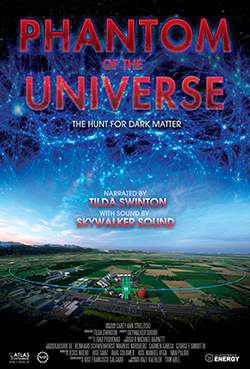
Hints of its effects on the matter we can see have been around for a century, yet the true nature of dark matter continues to elude us. Journey from mountaintop observatories to subterranean atom smashers and particle detectors with scientists hot on the trail of the invisible stuff that shapes galaxies. Narrated by award-winning actress Tilda Swinton.
A live sky tour follows the program, featuring constellations, planets, the moon and other items of interest currently visible in the sky, with tips for finding your way around in the heavens on the next clear night, and stories about the stars.
Recommended Grades
- 5th through 12th+
Concepts
- Birth of the universe
- Atomic and subatomic particles (quarks, protons, neutrons, electrons, etc.)
- Structure of the universe (galaxies and galaxy clusters)
- Newton's Law of Gravitation
- Evidence for existence of dark matter
- Detection of dark matter via the Large Hadron Collider’s Atlas instrument
- Proton-proton collisions
- Nature of dark matter
- Supersymmetry theory of elementary particles
"Cosmic Colors: An Adventure Along the Spectrum" (w/ live sky tour)

The universe is awash in radio waves, infrared light, visible light, ultraviolet light, microwaves, x-rays, and gamma rays, pouring forth from various celestial objects. So, what do all of these forms of electromagnetic energy have in common, and what makes them different? Learn about the electromagnetic spectrum and common, everyday occurrences and uses of these forms of energy in this fast-paced adventure.
A live sky tour follows the program, featuring constellations, planets, the moon and other items of interest currently visible in the sky, with tips for finding your way around in the heavens, and stories about the stars.
Recommended Grades
- 5th through 12th+
Concepts
- Electromagnetic spectrum
- Visible light
- Infrared
- Radio waves
- Ultraviolet
- Gamma rays
- Wavelength and frequency
- Color
- Speed of light
"Two Small Pieces of Glass: The Amazing Telescope" (w/ live sky tour)
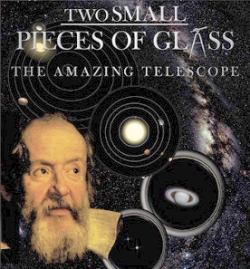
Just over 400 years ago, using Dutch lens maker Hans Lippershey's invention, Galileo started a revolution. Turning his crude "spy glass" telescope skyward, he recorded the wonders he saw and changed the world forever. Four centuries later the telescope has evolved into modern wonders of technology like the Hubble Space Telescope. Join two young astronomy enthusiasts and their astronomer friend as they explore the universe and learn why telescopes are such important tools of science.
A live sky tour follows the program, featuring constellations, planets, the moon and other items of interest currently visible in the sky, with tips for finding your way around in the heavens, and stories about the stars.
Recommended Grades
- 5th through 12th+
Concepts
- Design and nature of telescopes
- History of astronomy
- Electromagnetic spectrum
- Optics
"Unseen Universe" (w/ live sky tour)
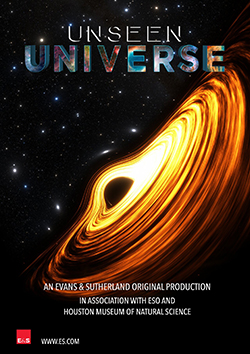
Look at the night sky and you are seeing the universe as humankind has for almost all of history. The visible light that our eyes detect has revealed much about the universe. Yet, it is only the tip of the iceberg: Radio, infrared, ultraviolet, x-rays, and other wavelengths of the electromagnetic spectrum carry a wealth of information about planets, stars, and galaxies. The relatively recent capability of detecting energy from across the spectrum, together with the added power of interlinking telescopes continents apart, is finally lifting the veil on the secrets of our unseen universe. Discover these technologies and their revelations on this journey into the realm beyond what our eyes can see.
A live sky tour follows the program, featuring constellations, planets, the moon and other items of interest currently visible in the sky, with tips for finding your way around in the heavens on the next clear night, and stories about the stars.
Recommended Grades
- 6th through 12th+
Concepts
- Electromagnetic spectrum
- Observing the universe across the entire spectrum
- Telescopes (Earth- and space-based)
- Galaxies
- Supernovae
- Black holes
- Neutrinos
- Gravitational waves
- Networking of telescopes
"Solar Superstorms" (w/ live sky tour)
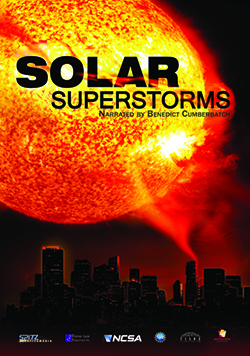
Our star, the Sun, goes through an 11 year cycle, from a period of relative quiescence building to a period of substantial sunspot activity and eruptions of prominences across its surface. During solar maximum, the Sun can discharge floods of charged particles into space by way of coronal mass ejections. Most of these ejections never cross paths with our planet, but those that do can affect space weather around the globe and spawn beautiful displays of the aurora borealis. While most geomagnetic storms are relatively harmless, occasionally the Sun spews forth a storm of particles so extreme it becomes a superstorm, with the potential to wreak havoc on our technologically dependent society. Discover the nature of our star and the danger it can pose.
A live sky tour follows the program, featuring constellations, planets, the moon and other items of interest currently visible in the sky, with tips for finding your way around in the heavens on the next clear night, and stories about the stars.
Recommended Grades
- 6th through 12th+
Concepts
- Star formation
- Supernovae
- Plasma
- Modeling the Sun with supercomputers
- Solar dynamics
- Magnetism
- Sunspots
- Coronal mass ejections
- Auroras
"Big Astronomy: People + Places + Discoveries" (w/ southern skies live sky tour)
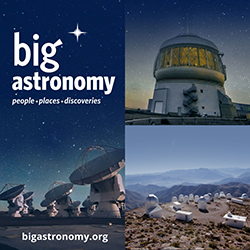
Take a trip high in the Andes Mountains of Chile to visit the observatories run by the European Southern Observatory. With their dry air, dark skies, and remoteness, central Chile's high peaks offer spectacular locations from which to study the cosmos. Discover not only the places of Chilean astronomy, but also the people with multitude STEM backgrounds working together to run the various telescopes and scientific instruments.
The program concludes with a virtual trip from southern Idaho to the Cerro Tololo Inter-American Observatory for a tour of the southern hemisphere night sky. See familiar constellations in not so familiar places and discover constellations not visible from Idaho and some of the celestial jewels of the sky south of the equator.
Recommended Grades
- 6th through 12th+
Concepts
- STEM careers in astronomy
- Electromagnetic spectrum
- Electromagnetic waves
- Extrasolar planets
- Galaxies
- Kuiper Belt
- Optical telescopes
- Planetary systems
- Radio telescopes
"Let It Snow" (available 11/30 - 12/17 only)

It’s a holiday treat for the eyes and ears, featuring festive fulldome video images choreographed to classic Christmas music. Enjoy seasonal tunes by Frank Sinatra, Chuck Berry, Burl Ives, Brenda Lee, and more, with a finale by the Trans-Siberian Orchestra. This family-friendly audio-visual experience is a great seasonal show to reward your students for reaching classroom performance goals, or just for a fun field trip.
Recommended Grades
- Pre-K through 12th+
Concepts
- None. It's just for fun!
"The Star of Bethlehem" (w/ live sky tour) (available 11/30 - 12/17 only)
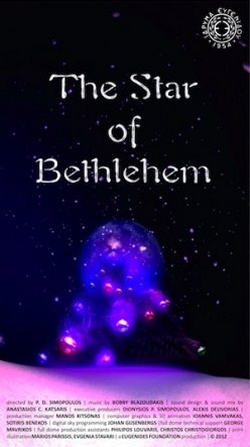
The age-old mystery of the Star of Bethlehem is explored in this Christmas planetarium program. Travel back in time to the Middle East and delve into the writings of the time, including scripture from the Bible, to search for clues to add to our modern scientific knowledge of the nature of the heavens above to see if there might be some natural explanation the star's appearance. Can the star be understood scientifically, or is its explanation only to be found in realm of the miraculous?
Note: This program has strong religious content.
A live sky tour follows the program, featuring constellations, planets, the moon and other items of interest currently visible in the sky, with tips for finding your way around in the heavens on the next clear night, and stories about the stars.
Recommended Grades
- K through 12th+
Concepts
- Lunar eclipses
- Origins of the modern calendar
- Comets
- Meteors
- Supernovae
- Planetary conjunctions
- Winter solstice
- Ancient perceptions of the nature and meaning of celestial objects and motions